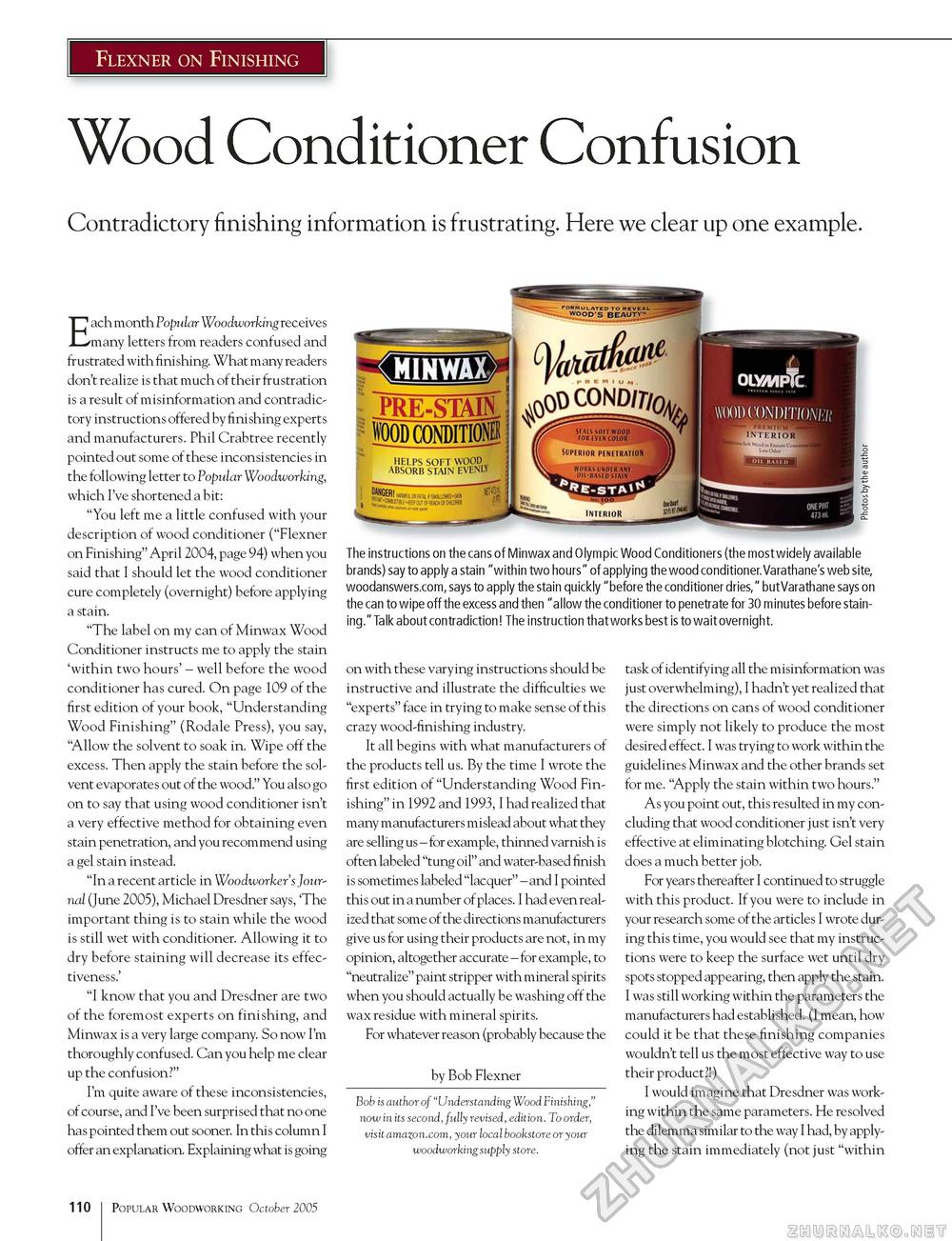Popular Woodworking 2005-10 № 150, страница 114
Flexner on Finishing Wood Conditioner Confusion Contradictory finishing information is frustrating. Here we clear up one example. The instructions on the cans of Minwax and Olympic Wood Conditioners (the most widely available brands) say to apply a stain "within two hours" of applying the wood conditioner. Varathane's web site, woodanswers.com, says to apply the stain quickly "before the conditioner dries," but Varathane says on the can to wipe off the excess and then "allow the conditioner to penetrate for 30 minutes before staining." Talk about contradiction! The instruction that works best is to wait overnight. Each month Popular Woodworking receives many letters from readers confused and frustrated with finishing. What many readers don't realize is that much of their frustration is a result of misinformation and contradictory instructions offered by finishing experts and manufacturers. Phil Crabtree recently pointed out some of these inconsistencies in the following letter to Popular Woodworking, which I've shortened a bit: "You left me a little confused with your description of wood conditioner ("Flexner on Finishing" April 2004, page 94) when you said that I should let the wood conditioner cure completely (overnight) before applying a stain. "The label on my can of Minwax Wood Conditioner instructs me to apply the stain 'within two hours' - well before the wood conditioner has cured. On page 109 of the first edition of your book, "Understanding Wood Finishing" (Rodale Press), you say, "Allow the solvent to soak in. Wipe off the excess. Then apply the stain before the solvent evaporates out of the wood." You also go on to say that using wood conditioner isn't a very effective method for obtaining even stain penetration, and you recommend using a gel stain instead. "In a recent article in Woodworker's Journal (June 2005), Michael Dresdner says, 'The important thing is to stain while the wood is still wet with conditioner. Allowing it to dry before staining will decrease its effectiveness.' "I know that you and Dresdner are two of the foremost experts on finishing, and Minwax is a very large company. So now I'm thoroughly confused. Can you help me clear up the confusion?" I'm quite aware of these inconsistencies, of course, and I've been surprised that no one has pointed them out sooner. In this column I offer an explanation. Explaining what is going on with these varying instructions should be instructive and illustrate the difficulties we "experts" face in trying to make sense of this crazy wood-finishing industry. It all begins with what manufacturers of the products tell us. By the time I wrote the first edition of "Understanding Wood Finishing" in 1992 and 1993, I had realized that many manufacturers mislead about what they are selling us - for example, thinned varnish is often labeled "tung oil" and water-based finish is sometimes labeled "lacquer" - and I pointed this out in a number of places. I had even realized that some of the directions manufacturers give us for using their products are not, in my opinion, altogether accurate - for example, to "neutralize" paint stripper with mineral spirits when you should actually be washing off the wax residue with mineral spirits. For whatever reason (probably because the by Bob Flexner Bob is author of "Understanding Wood Finishing," now in its second, fully revised, edition. To order, visit amazon.com, your local bookstore or your woodworking supply store. task of identifying all the misinformation was just overwhelming), I hadn't yet realized that the directions on cans of wood conditioner were simply not likely to produce the most desired effect. I was trying to work within the guidelines Minwax and the other brands set for me. "Apply the stain within two hours." As you point out, this resulted in my concluding that wood conditioner just isn't very effective at eliminating blotching. Gel stain does a much better job. For years thereafter I continued to struggle with this product. If you were to include in your research some of the articles I wrote during this time, you would see that my instructions were to keep the surface wet until dry spots stopped appearing, then apply the stain. I was still working within the parameters the manufacturers had established. (I mean, how could it be that these finishing companies wouldn't tell us the most effective way to use their product?!) I would imagine that Dresdner was working within the same parameters. He resolved the dilemma similar to the way I had, by applying the stain immediately (not just "within 110 Popular Woodworking October 2005 |








